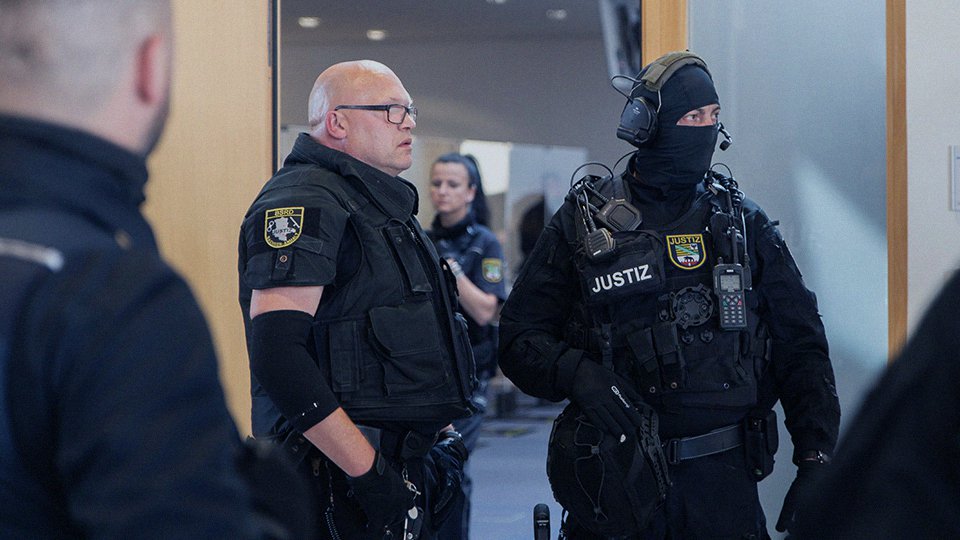The Co-Plaintiffs Crack the Accused’s Aloofness

The second day of the trial began with reading letters from Stephan B.’s relatives by the defense, according to which all family members of the accused – father, mother and sister – who had been summoned as witnesses would make use of their right to refuse testimony. The judge responded with accepting the witnesses’ refusal. Individual representatives of the co-plaintiffs asked how did the defense get these letters, as well as why they were not sent directly to the high regional court. They continued their argument, that if the defense of Stephan B. had advised his family members, it could be seen as a conflict of interests. This hypothesis was denied by the defense.
Following this, the video which the accused live-streamed during his alleged crimes was played in the courtroom, which includes documentation of essential parts of the crime. The accused grinned repeatedly while the video was played, which drew the attention of the court and the viewers.
Following a 45-minute break, the representatives of the prosecution – Federal Prosecutor Lohse and Senior Public Prosecutor Schmidt – began questioning the accused. When asked why his aim shifted from Jews to Muslims during the execution of the attack, B. said that if since he did not reach the “cause” (the synagogue), he had to switch “for better or worse” to the “symptom” (Muslims). It is not the first time on that day, or even the whole trial, that the accused unmistakably referred to the conspiracy ideology of the “Great Replacement”, which claims that European population is being replaced with Muslims (thus establishing hostility against them), while the “puppet masters” of this plan are others than Muslims (quite often in this context, as in the case of Stephan B., “the Jews” are named as such). During the interrogation, the accused reaffirmed his antisemitic intention to kill the visitors of the synagogue. Attacking the synagogue was “no mistake”, he said, while leaving no doubt about his lack of empathy towards the victims.
Following the questioning by the prosecution, the accused was questioned by his two defense lawyers. The co-plaintiff representatives repeatedly and successfully objected the defense’s questions as they were aimed at a legal assessment by the accused or were asked suggestively.
The defense counsel, Weber, attempted to follow a line of questioning, which points out that the accused had no concrete evidence that there were actually people in the synagogue. He attempted to support this argument by exemplifying the accused’s research, which according to the accused’s statement found that synagogues were sometimes monuments and thus empty buildings. The judge objected this line of argumentation, as it did not match the accused’s statements from the previous day. Following this, the defense requested a verbatim transcript of the accused testimony, which are relevant to the discussed topic. This request was rejected by the judge and the Senate, since it did not meet the prerequisites for such a request: the argument did not depend on the wording of the statement cited by the defense counsel, but on its meaning in the context of the accused’s statement.
In response to a question from the judge, the accused revealed that he did not expect to get far with his damaged getaway vehicle. Otherwise, according to Stephan B, he would have probably driven to Halle-Neustadt to attack an Islamic cultural center there.
Finally, the floor was given to the representatives of the co-plaintiffs. Some insisted on a very clear approach – to make it clear to the accused that they would not give him or his ideology a stage. Other co-plaintiffs tried to confront him with his ideology and lead his racial thought-construction into absurdity through their questioning.
In the course of the questioning by the co-plaintiffs’ representatives, the topic of contacts that B. had on the Internet came up. Although he always stressed that he did not know or meet the persons he communicated with on the Internet personally, he reported that he exchanged information on the darknet in chat forums about his experiments with construction of weapons (but without direct connection to his crime). He explained that there are rooms on the darknet where he can “talk more freely”. However, he vehemently refused to name the platforms and websites on which he communicated with others nor from which he obtained information, as he “didn’t want to shit on anyone” and wanted to protect “his own people”.
As on the previous day, the accused did not miss any opportunity to spread his antisemitic, racist and anti-feminist ideology. It became clear again and again how these different elements of his thinking intertwine. His antisemitism seems to take on a kind of superior function, as he blames the Jews both for his hostility towards non-whites (because they were responsible for the alleged population replacement) and for the feminism he hates (which he calls “Jewish”).